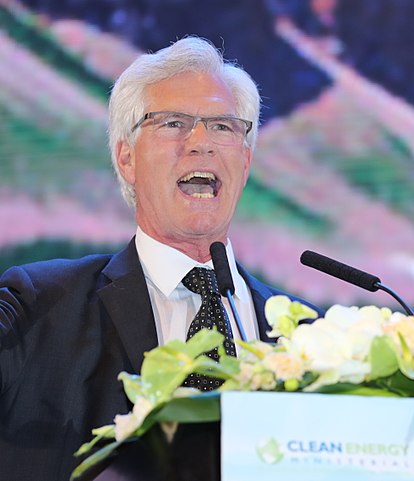
OTTAWA — Jim Carr’s view of enhancing Canadian trade in Asia — and its biggest prize, China — is rosier these days because he’s seeing the possibilities through a new lens: LNG Canada’s new $40-billion liquefied natural gas project in northern B.C.
“The most interesting development in Canada’s relationship with China happened (Tuesday),” the new minister of international trade diversification said in an interview one day after the historic announcement to build the long-awaited LNG plant in Kitimat, B.C.
“What we’ll be able to say to our potential customers is that this now is real and there will be timetables.”
Carr is so buoyant about the door-opening possibilities of shipping cleaner energy across the Pacific that he categorically discounts the effect of another surprise on the trade file this past week.
He sees no obstacle in the controversial clause in the U.S.-Mexico-Canada Agreement that allows any of the countries to withdraw from the deal on six-month’s notice if one of the partners enters into a free trade agreement with a non-market economy — China, again.
“There’s nothing in the trade agreement with Mexico and the United States that stops Canada from that. The deal has no impact on Canadian sovereignty or the capacity of the Canadian government to do business around the world,” Carr said.
Carr’s job is to find new trading markets for Canada beyond its largest trading partner, the United States. The word “diversification” was conspicuously added to his job title during a July cabinet shuffle and the minister is clearly thrilled with what he sees as the LNG arrow in his quiver.
Given the rocky, insult-laden, 14-month road to a new North American trade deal, the need to fulfil the promise of diversification has never been greater for Canada. Carr is also eyeing India, South America, and other Asian countries, as well as pushing for the speedy ratification of the new Trans-Pacific Partnership.
He is hoping to travel to China next month, though he stops short of calling for all-out free trade with the country that is the subject of so much Trump administration ire.
“I would say there are lots of possibilities for sectoral trade. We know the LNG possibility is real. We know that the Chinese Canadian community is very interested in deepening ties.”
The distinction Carr makes is significant. An attempt to launch formal free trade talks last winter stalled because Chinese leaders flatly rejected the Trudeau government’s progressive trade agenda that would have included labour, gender and Indigenous rights.
And then there’s that surprise clause in the new USMCA. It requires a member country to provide notice and information to the other two partners if it plans free trade talks with a “non-market” economy. It gives the other partners a say in the text of such a deal.
The Chinese embassy in Ottawa blasted the inclusion of the new clause because it unfairly targets China’s potential trading partners, and unfairly brands it as a “non market” economy.
Trade experts and analysts support the careful approach that Carr advocates because it gives Canada room to talk to China without overtly angering the United States.
“The Americans may still take notice but there’s nothing to stop Canada from continuing to have productive conversations with the Chinese in areas that we have common interests,” said Meredith Lilly, a trade expert at Carleton University.
Lilly said the non-market economy clause is unusual and represents a new way for the Trump administration to force its allies to “pick sides” in its ongoing trade dispute with China that has seen billions of dollars of tariffs imposed on Chinese goods, and retaliation by Beijing.
“You can view those as targeted at China, and the U.S. creating a template for future trade agreements with other countries beyond Mexico and Canada,” said Lilly.
Derek Burney, who was a key player in the Brian Mulroney government that negotiated the original Canada-U.S. free trade deal, said he’s not convinced the clause has any teeth to prevent Canada from moving forward economically with China, which he urged the government to do “as assertively” as possible.
“We have misfired in our approaches to China thus far. We have to redouble those efforts and get more serious, and not just with China, but with India as well,” he said.
“China’s going to be the No. 1 economy in a number of years, not decades. We’ve got to take it more seriously.”
Burney said business needs to do more to find opportunities to capitalize on the major trade deals that Canada has already completed with the European Union and South Korea, among others, as well as the new TPP that the Trudeau government hopes to ratify this fall.
“I don’t see as much evidence yet of our companies taking advantage of the openings that those agreements are giving us,” said Burney. “The biggest handicap in Canada is complacency. We’ve become comfortable in the cocoon of dealing with the Americans for 75 per cent of our trade.”
Carr is anything but complacent.
A full legislative effort is being made to ensure the rebooted TPP will be ratified this fall, giving Canada so-called first-mover advantage by being among the first six counties in the 11-country Pacific Rim pact to benefit. Meanwhile, Canada’s battalion of 1,000 trade commissioners and a newly created Invest in Canada agency are pushing hard on all fronts, said Carr.
“All of it plays to the heart of our strategic investment, which is to safeguard the most important trading relationship for Canada, which we have done, while expanding possibilities, which we are doing.”